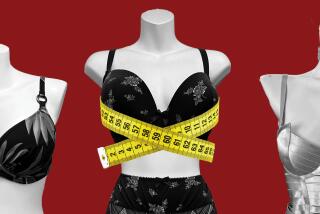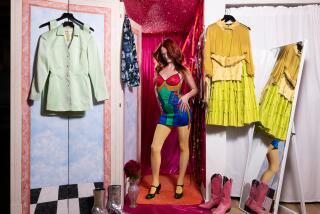What’s With Women’s Clothing Sizes? Industry Balks at Uniform Standards
- Share via
If anybody is clued in to the weirdness of women’s apparel sizing, it’s Monica Kitt, a Los Angeles stylist whose job it is to outfit people who appear on a television makeover show.
“Every day I deal with buying clothes for all kinds of women,” Kitt said. “If somebody tells me they’re a 10, I buy an 8 -- and a 10 and a 12.”
Women through the ages have griped about not being able to find clothes that fit properly. Their predicament is getting new attention as manufacturers, retailers, researchers and entrepreneurs wrestle to inject some sense into apparel sizes, the smallest of which have sunk to a mind-bendingly low 00 in some U.S. stores.
Most apparel manufacturers and retailers size clothes arbitrarily, often as a competitive tool. That makes it virtually impossible to get everybody on the same page.
Still, there’s no shortage of ideas on how to make visiting the dressing room less painful. For businesses, the stakes are high.
“It’s probably the most complex, relevant issue in the apparel industry today,” said Ilona Foyer, owner of Shapely Shadow Inc., a Malibu mannequin maker.
A Pennsylvania company called Intellifit Corp. is peddling a machine that uses radio waves to scan a woman’s shape, calculate measurements and identify brands best suited to her body. (The scanner will make its California debut this week at the Levi’s store in Santa Monica at Third Street Promenade.)
Fit Technologies Inc. of Dallas says apparel makers that use its Fitlogic system can produce garments sized to suit 84% of women aged 35 to 55.
Shapely Shadow uses scanners to clone real bodies to make realistic dress forms. So fastidious is its process, Foyer said, that “I now have 33 different size 8s.” Such fine-tuning means retailers can better fit their target customers, she said.
Cynthia Istook, on the other hand, would like to reel in the industry and is pushing for the adoption of truer national standards.
Women “end up buying the least of the worst because we have to have clothes,” said Istook, a North Carolina State University textiles professor. “It’s a huge problem.”
It’s huge enough that the industry is planning a conference in September on the shape and fit of women’s clothing, sponsored by the American Apparel and Footwear Assn., the National Retail Federation and the Fashion Institute of Technology in New York.
Not all women are in a twist over sizes. There are those who get a kick out of trying on 17 pairs of jeans, considering it part of the sport of shopping.
L.A. resident and TV scriptwriter Ellie Herman, for example, accepts things as they are.
“Ninety percent of the stuff I try on looks bad on me whether it fits or not,” and that’s regardless of the number on the label, she said.
Nevertheless, the current sizing system, or lack thereof, makes clothes shopping for most women an exercise in frustration. Market research firm NPD Group Inc. queried more than 47,000 women last month and found that almost half “hated” to try on clothes and more than half found it “somewhat” or “very” hard to find fashions that fit.
“For women, it is a very emotional and passionate subject,” said Marshal Cohen, NPD Group’s chief industry analyst. “It also consumes a tremendous amount of their time.”
Believe it or not, there already are sizing standards, though it’s unclear who follows them.
The standards, based on data gathered over nearly seven decades, continue to evolve but generally remain geared to the hourglass figure (think 36-26-36), which accounts for only 8% of women, said Istook, who has researched the female form. By her reckoning, nearly half of American women are rather rectangular (more like 41-34-42). The second-most-common shape is called the spoon. (Don’t ask.)
The first set of standards was devised in 1958 after catalog sellers such as Sears, Roebuck & Co. and Montgomery Ward, fed up with customers returning so many garments, asked for guidelines. They were based on a 1939 study conducted under a Federal Work Projects Administration grant, a major effort involving 58 painstaking measurements of nearly 15,000 volunteers across seven states.
Unfortunately for future shoppers, the volunteers, who were measured with and without girdles, were not exactly representative. A disproportionate number were young, single city dwellers. Women of color were intentionally excluded.
There have been many studies since, most recently the Size USA National Sizing Survey, which was released last year. The nonprofit Textile Clothing Technology Corp. did the work -- more than 10,000 bodies were appraised by 3-D scanners -- and sponsors included Federated Department Stores Inc., J.C. Penney Co., Target Corp. and Jockey International Inc.
Most sponsors won’t say how they are using the data, if at all. Apparel makers are usually cagey about their sizing techniques and theories, seeing them as competitive.
The few companies that will say they are tapping the Size USA data are doing so on their own, not giving much hope to proponents of a harmonized sizing scheme for the women of the nation.
Indeed, many in the industry believe that the chances for an across-the-board, uniform method of sizing clothes are slimmer than a perfect size 0. Companies, for the most part, act arbitrarily, developing their own size specifications based on dimensions they think will suit their target customers.
“They all want to do their own thing,” said Jim Lovejoy, industry programs director for Textile Clothing Technology Corp.
What’s known as vanity sizing has a lot to do with the off-the-wall state of affairs in the off-the-rack clothing industry. And were there a vanity sizing contest, baby boomer retailer Chico’s FAS Inc. might win: Its garb comes in 0, 1, 2 and 3. A size 1 at Chico’s is equal to an 8 or 10, said a spokeswoman for the retailer, which also makes liberal use of elastic waistbands.
More often, vanity sizing simply takes what might once have been considered, say, a 12 and turns it into a 10 or even an 8, generally depending on the price tag. This works better than Prozac -- so long as a woman sticks with one retailer or brand.
The smallest size appears to be the 00 found at American Eagle Outfitters and Abercrombie & Fitch Co., teen retailers that work to accommodate the leanest of young females.
“They create these sizes that don’t even exist,” said stylist Kitt, a 23-year-old wearing a size 2 skirt and white camisole for a recent sprint to the Grove shopping center in Los Angeles. “If a girl fits into a 00 in this society, she’s going to feel great about herself. And she’s going to want to buy those jeans.”
In fact, Kitt said, she can’t find designer jeans for women who wear a size 12 or larger, so she has to get men’s sizes.
“It’s a way of weeding people out -- like ‘You’re not good enough to buy our jeans,’ ” she said.
None of it makes sense to Istook, who has been struggling with fitting clothes since she began making them at age 10 and discovered that the patterns she bought were unreliable.
“I had to alter them every time,” she said.
When she got hold of the Size USA numbers, she was inspired. She pored over Gray’s Anatomy and ectomorphic and mesomorphic studies to gain a better understanding of slimmer and more muscular body types and examined ratios of key body parts: bust, hips, waist, stomach, abdomen and high hips. What is a bust likely to be, given a specific waist? How do you account for shifts that occur as we age, such as bottom drooping or stomach sagging?
After consulting with other experts and asking statisticians to crunch the numbers, she felt confident that she had pinpointed nine shapes that would cover everybody. They were rectangle, spoon, triangle, inverted triangle, hourglass, top hourglass, bottom hourglass, oval or diamond. And each shape would be sub-categorized in petite, regular and tall. That would mean 27 sizing systems.
Retailers were unlikely to bite, the professor realized. She shelved the oval and diamond shapes because they represented the smallest percentage of women.
“We don’t have the answer for everybody,” said Istook, a self- described bottom hourglass who morphs into a rectangle when she loses weight. “We’re just trying to get as close as we can.”
In March she traveled to Philadelphia and presented her body shapes to the Standards for Body Measurements committee of ASTM International, an organization that sets technical standards for industries.
It’s one of many ASTM panels that niggle over tiny things -- zippers, buttons, snaps -- and are not forums for rapid change. Decisions about whether and how to change standards are made after months, if not years, of discussion by panel members, who represent retailers, manufacturers, designers, government agencies and research outfits.
Getting all those interests lined up can be about as easy as threading a needle with a rope, if the committee meeting in Philadelphia was any indication.
Among those in attendance were pattern developers, a fit-standards engineer, a research anthropologist and a body-scanning consultant from France. For two days, they chewed over ratios and contours, reflected on age and height, and mused over low stomachs and high hips. They agreed, at least, on one key point: They will meet again in October.
“Basically,” Istook said, “we didn’t get anywhere.”
Cricket Lee, the founder and chief executive of Fit Technologies, says she is making progress. The company has just struck its first licensing agreements with two apparel makers -- Jones Apparel Group Inc. and GM Design Group Ltd.’s Garfield & Marks -- to make pants according to “FitKit” specifications, she said. They will be called Fitlogic and will come in three shapes (currently curvy, straight and round, although that’s likely to change).
At 52, Lee relates to the struggles that female baby boomers have in finding clothes. Once a “shopaholic,” she now hates shopping.
“I get a pair of pants and the waistline always comes up right under my bra,” she said. “I have to have everything altered or roll it down.”
Intellifit installed its first scanners in Lane Bryant stores in April so that the plus-size women’s retailer could get a better fix on its customers, President Ed Gribbin said.
The machines take 200 body measurements in about 10 seconds, he said. More than 11,000 Lane Bryant customers have been scanned, providing information the retailer can use to do a better job of sizing clothes, he said.
“Improving fit means improving sales for apparel brands,” Gribbin said.
His company plans to install scanners in six shopping centers owned by General Growth Properties this summer. Customers can collect the results from their scans and then head to the stores that sell the brands most likely to fit them. Although only 15 brands have signed on, Gribbin said, he predicted that others would soon join because they would not want to lose out to competitors.
For her part, Marisol Castellanos would spend more money if she could find more clothes that fit. The last time the 34-year-old legal secretary from Randolph, N.J., shopped for jeans, she tried on about 10 pairs before finding a brand that suited her. When she did, she bought four pairs, in different colors and washes.
If the store hadn’t run out, Castellanos said, “I would have bought four more.”
*
(BEGIN TEXT OF INFOBOX)
Having a fit
Apparel industry standards are geared to women with an hourglass figure, yet most women have a figure that is closer to a rectangle, according to one study.
Hourglass figure: Bust and hips balanced; well-defined waist. Percent of women with this shape 8%
Rectangle figure: Little or no waist definition; underarm and hips are balanced. Percent of women with this shape 46%
Source: Cynthia Istook, North Carolina State University






